What are Soccer Rondos?
Soccer Rondos are short, fast-paced passing drills designed to improve ball control and decision making in tight spaces. Players stand in a circle with one or two defenders in the center trying to win possession of the ball. The drill emphasizes quick passes and movement off the ball, allowing players to maintain possession while under pressure.
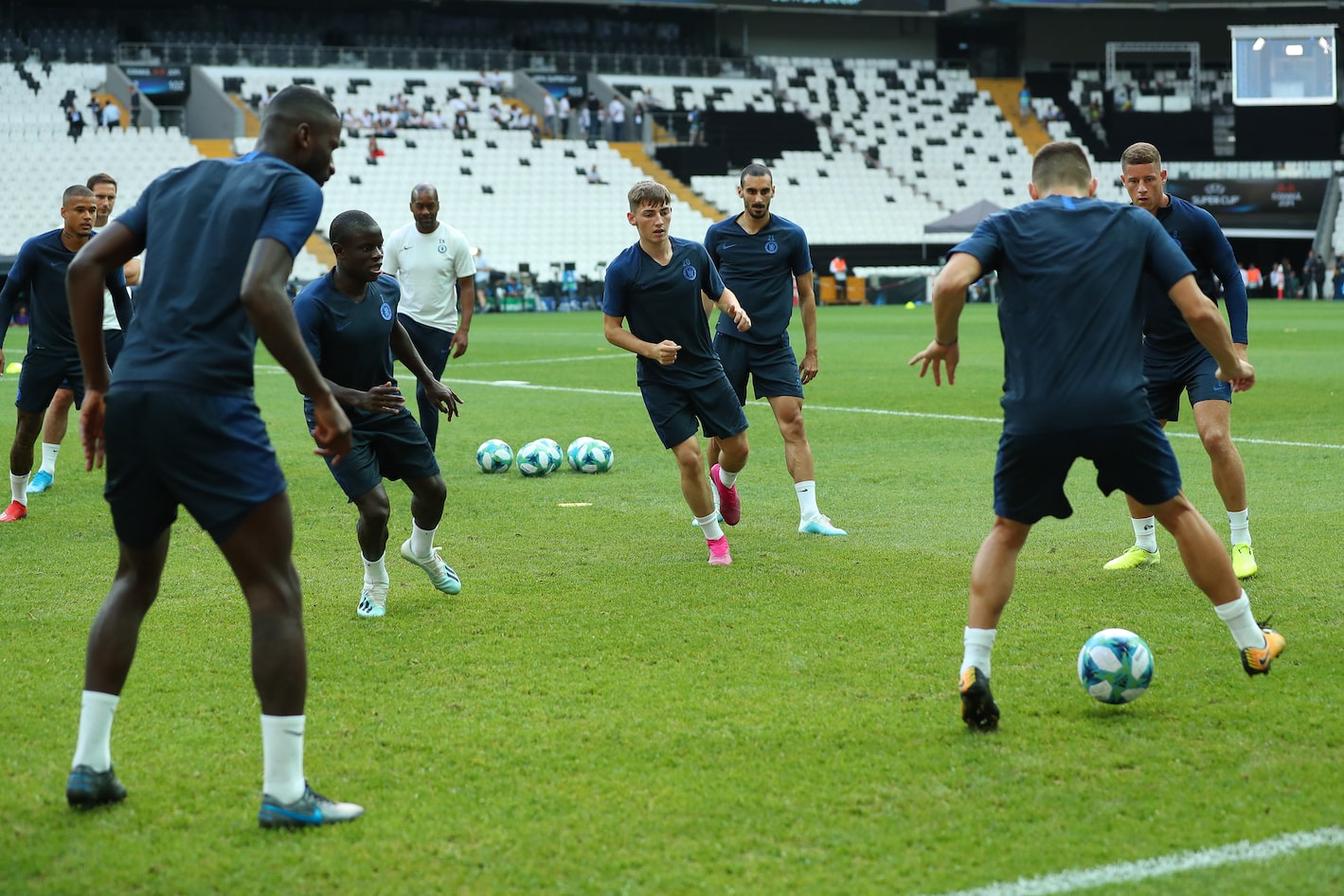
Definition of Rondos
The term "rondo" originates from the classical music genre and refers to a musical piece where a recurring theme alternates with contrasting ones. In soccer training, rondos are small-sided games that focus on quick passing, movement off the ball, and decision-making under pressure. There are three types of rondos: basic (three players vs one), intermediate (four players vs two), and advanced (five or more players vs two). Rondos are an effective way for coaches to develop their team's technical skills while also promoting a style of teamwork, communication, and competitiveness. By creating smaller areas of play with strict rules about possession of the ball, coaches can create situations that simulate real-game scenarios which provide an advantage in competitive matches.
Benefits of Soccer Rondos
Soccer rondos have several advantages that can benefit any team's performance. These drills improve passing accuracy and speed, allowing players to move the ball around the field with ease. In addition, they enhance team communication and coordination by requiring quick decision-making and efficient movement on and off the ball. Finally, soccer rondos teach better decision-making skills under pressure, enabling players to make optimal choices in competitive game situations.
Coaches who incorporate soccer rondos into their training sessions will see a noticeable improvement in their teams' abilities. By focusing on these areas of play during practice sessions, coaches can help players develop their skills both individually and as part of a cohesive system. Ultimately, mastering soccer rondos is one of the best ways for athletes to hone essential techniques while also gaining confidence in their ability to perform under pressure on game day.
How to Set Up a Rondo Drill
When setting up a Rondo drill, it's important to consider the numerical split of the teams. The ideal number is usually between five and ten, as this provides an advantage in terms of ball control and movement. Additionally, selecting an appropriate playing area size for your team's skill level is crucial to success. It's best to start with a smaller area and gradually increase it as your players become more competitive.
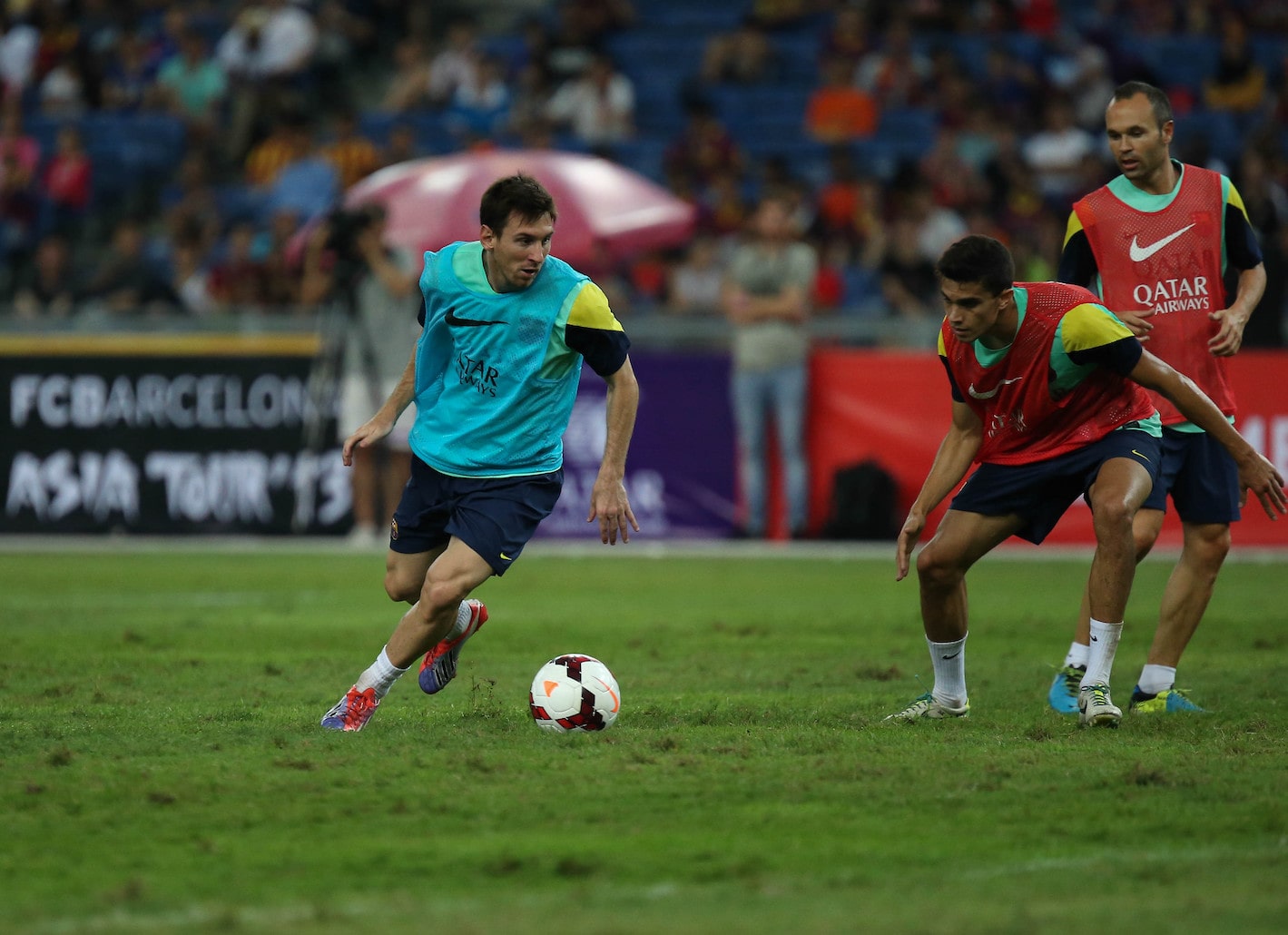
To keep things interesting during Rondo drills, incorporating variations can be very effective. For example, you could switch from two-touch to one-touch play or have players move away from the center circle after making their pass. Coaching tips like these will make sure that your team stays engaged while they practice their skills in soccer rondos.
Different Types of Rondos
Circle, triangle and square are the different types of soccer rondos that coaches can incorporate into their training sessions. The circle rondo focuses on improving ball control and passing accuracy through quick transitions in a circular formation. Triangle rondos aim to improve communication and movement off the ball in a triangular shape. Square rondos focus on developing spatial awareness, decision-making skills and executing passes accurately within a confined space.
Each type of rondo has its unique benefits for players, helping them develop specific skills needed for successful gameplay. Coaches can mix up drills by alternating between these different shapes to keep players engaged and challenged throughout training sessions.
1. Circle Rondo
Circle Rondo is a popular soccer training drill that helps players improve their passing and movement skills. The objective of Circle Rondo is to maintain possession of the ball by passing it around the circle while two defenders try to intercept it. This drill can be used to train all players, but particularly midfielders and forwards who need to have good awareness on the field and use quick passes to move the ball forward and keep away defenders. To make Circle Rondo more challenging, coaches can increase or decrease the size of the circle or add restrictions such as using only one touch passes.
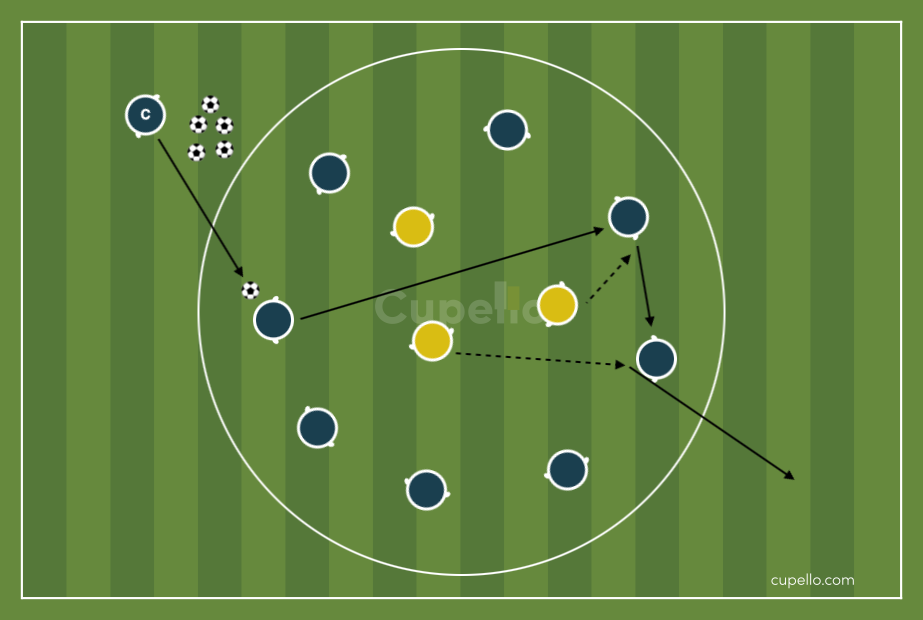
2. Triangle Rondo
The Triangle Rondo is a popular soccer drill that focuses on maintaining possession of the ball. In this drill, three players form a triangle and work to keep the ball away from one defender in the middle. The key to success in this rondo is quick thinking and precise passing. Coaches can use this drill to improve their team's ability to move the ball quickly and maintain control even under pressure or overloads.
To make the most of Triangle Rondos, coaches should encourage their players to communicate effectively with each other throughout the game. Players need to be aware of where their teammates are at all times so they can pass effectively and avoid losing possession of the ball. Additionally, coaches may want to adjust certain aspects of this drill depending on their team's specific needs, such as changing player positions or adjusting field size.
3. Square Rondo
In Square Rondo, four defenders occupy the corners of a square while five attackers pass the ball around them. This drill helps improve players' ability to retain possession under high pressure and their overall passing skills. One coaching tip is for defenders to communicate and work together to anticipate passes and intercept them, while attackers should focus on quick movement and crisp passes to keep possession. Another tip is for coaches to vary the size of the square based on their team's abilities - smaller squares create more difficulty for attackers, while larger ones allow for more space but still offer defensive challenges.
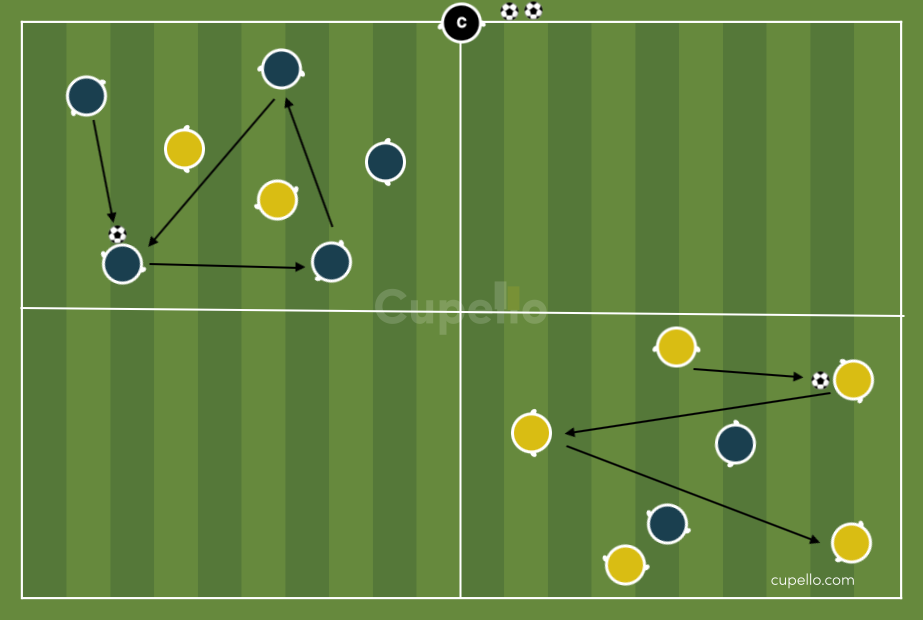
20 Rondos Training Guide
Engaging in Rondos fosters growth in passing, receiving, decision-making, and teamwork aptitudes in an enjoyable manner. This translates to enhanced game performance, ultimately contributing to the team's increased likelihood of securing victories.
Coaching Tips for Soccer Rondos
During soccer rondos, it's essential to emphasize communication between players. Effective communication can help improve decision-making and ensure the success of the drill. Encourage your team to talk to each other during play and provide clear instructions for passes and movements.
In addition, focus on technique while practicing soccer rondos. This will allow players to develop their skills and become more comfortable with ball control. Encourage quick decision-making by setting time limits or limiting touches on the ball. Incorporating role-specific rondos can also be beneficial, allowing players to practice specific positions or scenarios within a game situation.
1. Emphasize Communication
Effective communication is key to success when practicing soccer rondos. As a coach, it's important to emphasize the need for your players to communicate with one another during drills and matches. This will help them stay organized, anticipate each other’s movements and make split-second decisions within moments of receiving the ball.
To encourage better communication, consider implementing these tips:
- Encourage verbal cues like "I'm open" or "man on"
- Teach hand signals that indicate where the ball should be played
- Conduct exercises specifically designed to improve communication skills
2. Encourage Quick Decision-Making
Encouraging quick decision-making is an essential aspect of soccer rondos. This drill involves players passing the ball quickly between themselves while keeping possession, forcing them to make split-second decisions on where and how to pass the ball. Here are some ways coaches can encourage quick decision-making during soccer rondos:
- Set a time limit for each round
- Increase the number of players involved in each rondo
- Introduce obstacles or cones in the playing area to simulate game-like scenarios
Another way to encourage quick decision-making is by incorporating role-specific rondos, which focus on specific positions such as midfielders or defenders. By doing so, players can practice making decisions that are relevant to their position on the field. With these tips, coaches can help their team improve their speed and accuracy when making critical game-time decisions.
3. Focus on Technique
Precise technique is fundamental in executing soccer rondos successfully. Players must be well-versed in passing, receiving and moving with the ball to maintain possession of it. Emphasize proper body positioning while playing rondos as it has a significant impact on how effectively players can receive or pass the ball.
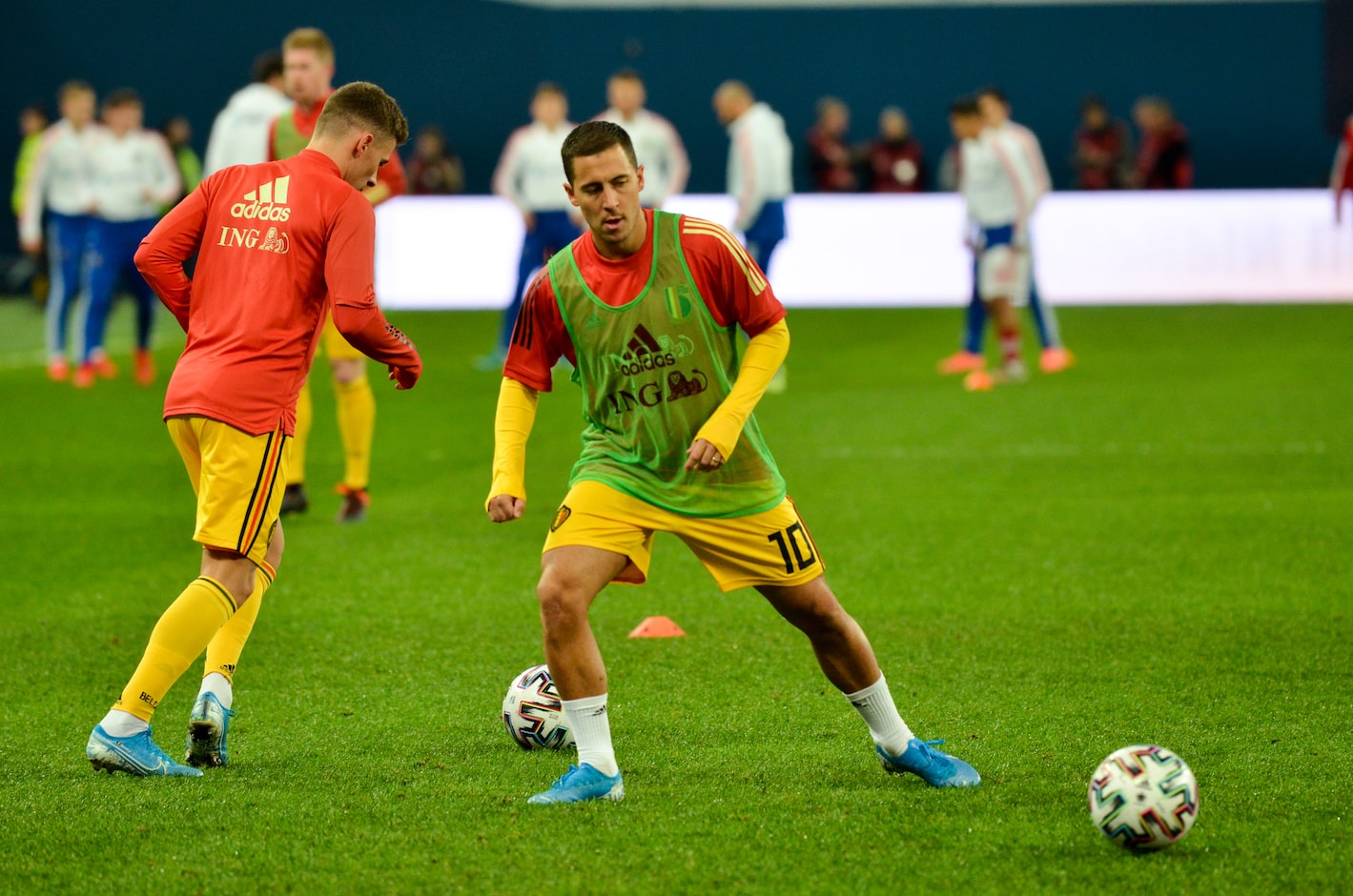
Another key element when focusing on technique during soccer rondos is encouraging players to use both feet interchangeably. This helps develop their ambidexterity, which can prove beneficial during match situations where they need to make split-second decisions without losing control of the ball. Encouraging this habit from an early stage ensures that your players develop more rounded skills, making them dynamic threats on the field.
4. Incorporate Role-Specific Rondos
To make the most of soccer rondos in training, it's important to incorporate role-specific exercises into your drills. This means creating scenarios that reflect individual positions on the field and help players build their skills accordingly. Here are a few ideas to get you started:
- Fullback Rondos: These exercises focus on improving the passing ability and decision-making of fullbacks, who often play a crucial role in transitions from defense to attack.
- Midfielder Rondos: Designed for midfielders, these drills emphasize ball control, quickness of thought, and tactical awareness.
- Striker Rondos: Forwards benefit from rondos that challenge them with tight spaces and encourage them to improve their finishing skills.
By tailoring your rondos to specific positions, you can ensure that each player gets the targeted practice they need to excel on game day.
Rodos Final Advice
Soccer rondos are an effective training tool for improving ball control and quick decision-making in tight spaces. Incorporating rondos into your team's practice routine can greatly enhance their overall performance on the field.
Furthermore, it is important to note that while rondos are beneficial for all players, they are especially useful for developing the skills of defensive positions such as center-backs and defensive midfielders. By implementing these drills regularly, coaches can help their players excel in these crucial roles and strengthen the team's defense strategy overall.


Improve Your GameJust 1.99 p/m
Exclusive drills and sessions, get involved today!
- 100’s of Drills
- Coach to Camera Videos
- Sessions from Pro’s
- Industry Leading Advice
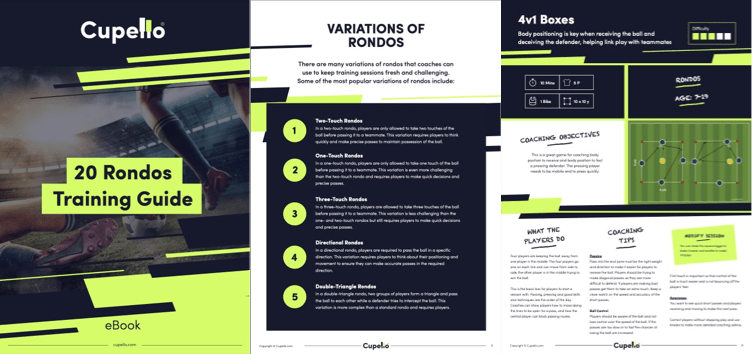


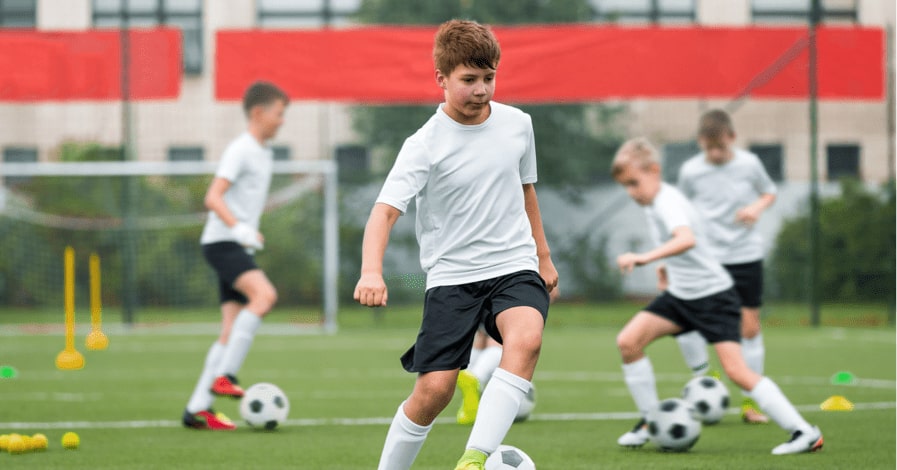


Cupello
Rethinking soccer coaching via our industry leading tools. Built to offer effective coaching development solutions for players and coaches of all levels.